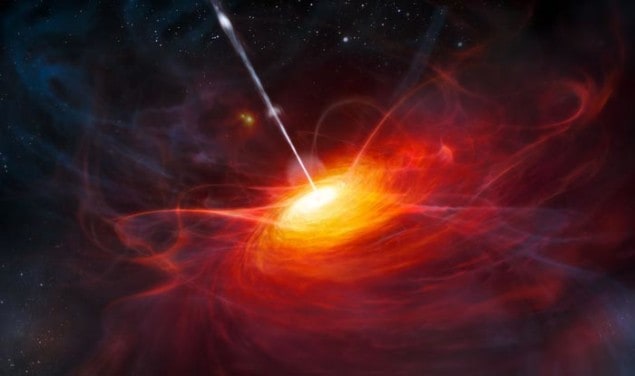
For the first time, astronomers have determined the chemical composition of gas from the first billion years of the universe’s life. The gas consists mostly of neutral hydrogen atoms, which means that it may mark the era before stellar radiation began ionizing the universe. Furthermore, the gas shows no signs of the heavy elements that are forged in stars so it may contain only the light elements produced by the Big Bang.
“We are starting to look back to the epoch that is probably when the first stars were turning on,” says Robert Simcoe, an astronomer at the Massachusetts Institute of Technology who built the instrument that acquired the spectrum of the far-off gas. “This is the very first [chemical] measurement that anybody has made in any environment at these early times.”
The Big Bang, which occurred 13.7 billion years ago, showered the cosmos with hydrogen and helium. Aside from a trace of primordial lithium, heavier elements – which astronomers call metals – arose later, after stars formed and exploded, casting oxygen, iron and other metals into space. Furthermore, the first stars radiated extreme ultraviolet light that ionized gas, tearing electrons from the hydrogen nuclei. The universe is still ionized today.
Farthest known quasar
To analyse the ancient gas, Simcoe and his colleagues examined the farthest known quasar. Named ULAS J1120+0641, this quasar resides in the constellation Leo and is so distant that its light travels 12.9 billion light years before reaching Earth. We see the quasar as it was just 770 million years after the Big Bang.
While the quasar’s light races toward Earth, space between the quasar and us expands, stretching the wavelength until it is 708% longer than it was at the start of its journey. Thus, astronomers say the quasar has a redshift of 7.08. Because of the high redshift, what was once far ultraviolet radiation appears to us at infrared wavelengths. To obtain the infrared spectrum, Simcoe’s team used the Magellan telescope in Chile.
The gas itself is much too faint to see. But quasars mark the brilliant centres of some galaxies, so Simcoe’s team searched for wavelengths at which intervening gas absorbed the quasar’s light. The gas is probably a few million light years from the quasar, he says, and so has no connection to it.
Two tantalizing scenarios
Simcoe presents two different scenarios to explain his team’s findings. “Either is interesting,” he says. The more likely: we are seeing the diffuse gas that pervaded space 770 million years after the universe’s birth. If so, then because the gas is neutral, it means astronomers have reached the epoch before reionization had fully occurred. Furthermore, the lack of detectable metals indicates the gas has no more than 1/1000 the metal-to-hydrogen ratio, or metallicity, of the Sun.
Alternatively, the gas could exist in a protogalaxy that happens to lie in front of the quasar. In that case, the metallicity of the gas is less than 1/10,000 solar – comparable to the most primitive star known in the Milky Way’s halo.
“This observation is bringing us directly to where the evolution of the cosmic metallicity started,” says Michele Fumagalli, an astronomer at the Carnegie Observatories in Pasadena, California, who was not part of the research team. “This is very exciting, and I think we are now really entering a new frontier for these types of studies.” Last year, Fumagalli and his colleagues discovered metal-free gas that existed two billion years after the Big Bang – a surprise, since all other gas at that time contains metals. In contrast, the new work reaches much further back in time.
Huge galaxy in the making?
However, Abraham Loeb, chairman of the astronomy department at Harvard University, offers a third explanation for the new observation: the gas is falling onto the galaxy that hosts the quasar. “Usually these very bright quasars reside in massive galaxies, and these massive galaxies grew dramatically during early times through in fall of gas,” Loeb says, noting that the observed gas differs in velocity from the quasar by only 711 km/s. If his idea is right, then we are watching the construction of one of the largest galaxies in the universe.
Whatever the case, Simcoe says, “We have got to find some more of these things. When you look at the first of something, you hope that it is representative, but until you see a few more, you cannot say for sure.”
Although astronomers have glimpsed galaxies at greater distances than this quasar, these galaxies are too faint to use in studies of foreground gas. Instead, such investigations require additional far-off quasars, which serve as brilliant background beacons whose radiation probes the nature of gas from the dawn of time.
Simcoe and his colleagues are publishing their work online today in Nature.



